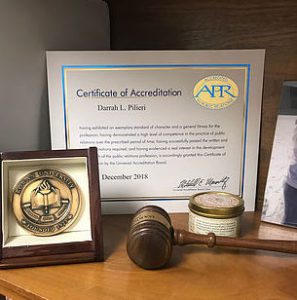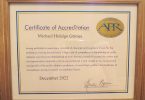April is APR Month at PRSA. Visit this link for more information about the Accreditation in Public Relations process.
One of the most rewarding experiences of my PR career was preparing for and obtaining my Accreditation in Public Relations. The APR designation demonstrates one’s ability to think strategically and validates a professional level of ethics, experience and competence.
I aspired to earn the APR after finding out the principals at my firm AKCG — Chris Lukach, APR (president) and Mike Gross, APR (senior vice president and chief operating officer) — hold the APR designation. After Chris approached me with the opportunity, I decided to pursue it for several reasons.
First, I wanted to build on the foundations of my PR degree and advance my strategic thinking abilities to better serve my clients and AKCG. Second, I wanted to stay current on best practices and emulate those with the APR designation, as they are regarded as professionals who practice with ethics and integrity — hallmarks to which I aspire in both my personal and professional life. Lastly, I wanted to set myself apart from my peers.
For those interested in pursuing the APR, here is some insight into the process.
Getting started
The best way to get started with the APR is understanding the expectations. The APR website breaks down the process in four steps, including:
- Completing and submitting the application
- Preparing for the review panel
- Studying for the Computer-Based Examination (CBE)
- Maintaining your Accreditation after passing the CBE
Prior to submitting my application, I attended an APR Boot Camp at a local university. Organized by PRSA’s Philadelphia Chapter, the Boot Camp was a six-hour program that provided me with a top-line overview of what to expect throughout the entire process, solidifying my decision to push forward on this journey.
Preparation
After submitting your application — assuming it’s approved — the most important next step is to prepare a timeline. Essentially, you have one year to complete the entire process, and having a timeline you can follow will help you execute it in manageable increments. Without a plan, you may fall victim to the “I have a whole year” mindset.
Plan to meet with your local Chapter’s APR Chair for helpful planning guidance, especially in the beginning of the process.
The Universal Accreditation Board accepted my application in January 2018, and I had to complete the process by January 2019. In March, I met with my APR Chair, and she provided me with some valuable direction, such as advising me on which case study to present during my review panel, how to format the Panel Presentation Questionnaire and what to expect during the review panel. She and I had regular check-ins, where she would ask me how the task of writing my questionnaire was going. Additionally, she encouraged me to get a draft of my questionnaire to her by a certain date, and because of this deadline, I was able to keep myself on track.
It is imperative to use the resources available to you. Without the resources I had at my disposal, I would have had a tougher time passing the review panel and CBE. I used the “short bookshelf” of texts to help understand, practice and embody the Knowledge, Skills and Abilities (KSAs) I would be evaluated on during my review panel and CBE. I used the following resources:
- Cutlip and Center’s “Effective Public Relations“
- “The Associated Press Stylebook”
- APR Study Guide.
I even enrolled in the APR Study Course, a self-paced course focused on the KSAs required to pass. Enrolling in it was the best decision I made. Through the weekly webcasts hosted by APR facilitators, the course helped put into context what I had been reading for several weeks. And better yet, it prepared me for the types of questions I would encounter on the CBE. In the end, the study course helped me understand all the pieces and how they fit.
Lastly, take the APR practice test, and take it often. Understanding the testing platform helped me feel comfortable with the process of answering the questions. Familiarizing myself with the testing platform before taking the test was one less thing I had to think about.
Execution
Writing the review panel questionnaire helps you identify your role in your organization, and it also helps you outline your review panel binder, which you present to the panelists. If possible, work with two of your peers, or other APRs, to help you refine your questionnaire and binder layout. I highly recommend presenting your review panel case study to a peer to become conversant in your presentation. It also is helpful to present to a non-PR professional, as they can provide feedback from a different perspective. If you signed up for the APR Study Course, this is a perfect opportunity to get a lot of practice and feedback from peers and APRs, which can help you refine your case study leading up to your presentation.
After you advance through the review panel, it’s time to really take in all facets of the KSAs and begin studying. Remember, trust your learning and studying processes. You know how you work best to prepare for tests. Knowing how your mind retains, processes and applies information will benefit you as you prepare for the CBE.
Lastly, as you study the theoretical principles outlined in the texts, make sure you consider their practical applications. The CBE is not a memorization test. As you read the material, take notes and memorize those terms you know you need to work on. But remember, the CBE assesses your knowledge skills and abilities to apply the KSAs to specific situations.
Remember, this is your journey and yours alone. It is a challenging and rewarding process and an accomplishment that validates hard work, dedication to the profession and the illustration of ethics.
From this newly minted APR, I wish you luck on your Accreditation journey!
Darrah L. Pilieri, APR, is a senior account executive at AKCG in Philadelphia.







